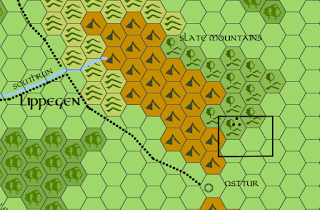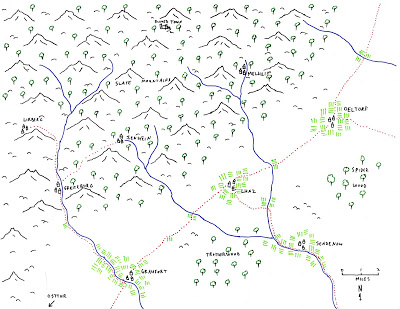I haven’t noted the locations of individual monsters yet. Since that’s something that will change over time, I’ll make a copy of this map and stock it with an initial load of creatures. As they get killed off or driven away, I’ll gradually restock the place. Most of the monsters will be in the wooded mountains, of course, but the Spider Wood is an obvious haunt of giant spiders, and I have a vague idea that the Trotterwood would be a good place for giant boar and wereboars.
There’s also the ruins of the Artanian town at the northern edge of the map. As indicated in the last post, this is where the locals believe most of their troubles are emanating. They’re partially right; there will certainly be some beasties in there. There’s also an orc tribe in those woods, too; the Spinebreaker tribe, who worship Dispater, lord of the second plane of Hell. Their exact home is unknown, but they are known to have several villages throughout the mountains, as they are semi-nomadic. They cause no end of trouble to the settlers, and thwarting them would be a great service.
The whole is known as the Greitzberg District.
The eight villages in the District are mostly agricultural in nature, with the four on the plains surrounded by well-tended fields. Each is centered around a fortified manor house, and ruled by a baron. The exception is the village of Greitzberg, which is ruled by a Freiherr, which means he is not a vassal of the Markgraf in Osttur, and enjoys a great deal more independence than the other villages in the district. This causes no small amount of ill-feelings, as the barons are jealous of his independent status. All of the villagers have the right to appeal a baron’s justice to the Markgraf, but the Freiherr’s rulings in judicial matters cannot be appealed. Each baron maintains a number of ritters (knights) to lead the defense of the village.
The mountain villages each have a small population of half-orcs, who are treated as second-class citizens. They are barely tolerated by the humans, but driven out by the orcs. On rare occasions, such half-orcs will return to the tribe after years of being raised in the human communities and treated so poorly. Such renegades assist the Spinebreakers in planning their raids.
Lirberg is primarily a dairy cattle-herding village, ruled by Baron Ludwig Erchendag. He is married to the daughter of the Freiherr of Greitzberg, so the two are on good terms. Several years ago the previous baron was turned into a vampire, but was eventually destroyed and his manor house abandoned and sealed. Ever since then, however, there are said to be more unusual happenings in the vicinity than can easily be accounted for. Population 330, 2 ritters, 66 militia.
Greitzberg is also a cattle-herding village, but supplements this with logging in the forest across the river. It is ruled by Freiherr Erwin Stadtler. His title comes from the fact that his village was founded prior to the Markgraf being granted his own title. The Markgraf thinks the world of him, however, and treats him like an honored guest whenever the Freiherr visits Osttur. The Markgraf will stay in Greitzberg on visits, and the two nobles will hunt together in the woods. Population 700, 4 ritters, 140 militia.
Jenstein is a logging town, but also sports a stone quarry that provides high-quality blocks of granite to the rest of the district and Osttur. It is ruled by Baron Krieg Lustorf. There is a dispute between Jenstein and Greitzberg, however, on where exactly the border between the two lies. It turns out there are two boundary stones, a half-mile apart, each claiming to mark the border. A group of bandits has taken advantage of the confusion and sometimes strikes in the disputed zone. Population 400, 3 ritters, 80 militia.
Melheim’s economy is centered on a pair of copper mines nearby, worked by a sizeable force of hill dwarves. The ingots are difficult to transport, however, making full exploitation of the resource difficult. The village is ruled by Baron Karl Urfein. They recently built a palisade wall to protect the village against constant raids by the orcs. The baron is experimenting with embracing the half-orcs in his community, organizing them into a militia unit specifically to deal with orc raids. Its success is yet to be determined. Population 370, 2 ritters, 78 militia.
Graufort is situated on a ford across the river, and is surrounded by extensive acres of farmland where mostly wheat and rye are grown. The current ruler is Baroness Ursula Megendorf, a young widow whose husband was killed in an orc raid. Graufort is also home to the largest temple of the Holy Family in the district, which gives the baron no little pride. Population 560, 4 ritters, 130 militia.
Lunz is a small farming village ruled by baron Josef Kreiten. He himself is an accomplished magic-user, and hopes to start a school for the mystical arts in the village. He has attracted a few students already. Population 300, 2 ritters, 60 militia.
Oeltorf is a small farming community ruled by Baroness Suzanne Woldkopf. She is an ancient matriarch of her clan, and the family or its relatives own half the farmland surrounding the village. She herself has 8 children, 23 grandchildren, and 7 great-grandchildren. It is said she has a touch of elven blood. Population 450, 3 ritters, 90 militia.
Sendenow is another farming village that grows barley and rye predominately, but also has a strong tradition of hunting boar in the nearby Trotterwood. The ruler is Baron Baldur Reichbach. Being the furthest from the Slate Mountains, Senenow has the least problem with raids from the Spinebreaker orcs, but between the Spider Wood to the north and the Trotterwood to the west, there are other dangers that plague the village, and so he maintains three knights and still makes sure the village militia drills weekly. Population 500, 3 ritters, 100 militia.










